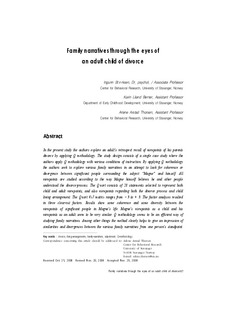| dc.contributor.author | Størksen, Ingunn | |
| dc.contributor.author | Berner, Karin Liland | |
| dc.contributor.author | Thorsen, Arlene Arstad | |
| dc.date.accessioned | 2010-06-24T07:51:44Z | |
| dc.date.available | 2010-06-24T07:51:44Z | |
| dc.date.issued | 2008 | |
| dc.identifier.citation | Journal of human subjectivity 6 (2008) nr.2 s. 25-44 | en_US |
| dc.identifier.issn | 1598-8643 | |
| dc.identifier.uri | http://hdl.handle.net/11250/185256 | |
| dc.description.abstract | In the present study the authors explore an adult’s retrospect recall of viewpoints of his parents divorce by applying Q methodology. The study design consists of a single case study where the authors apply Q methodology with various conditions of instruction. By applying Q methodology the authors seek to explore various family narratives in an attempt to look for coherence or divergence between significant people surrounding the subject “Magne” and himself. All viewpoints are studied according to the way Magne himself believes he and other people understood the divorce process. The Q sort consists of 28 statements selected ‐ ‐ to represent both child and adult viewpoints, and also viewpoints regarding both the divorce process and child living arrangement. The Q‐sort 4x7 matrix ranges from – 3 to + 3. The factor analyses resulted in three clear‐cut factors. Results show some coherence and some diversity between the viewpoints of significant people in Magne’s life. Magne’s viewpoints as a child and his viewpoints as an adult seem to be very similar. Q methodology seems to be an efficient way of studying family narratives. Among other things the method clearly helps to give an impression of similarities and divergences between the various family narratives from one person’s standpoint. | en_US |
| dc.language.iso | eng | en_US |
| dc.publisher | Korean society for the scientific study of subjectivity | en_US |
| dc.subject | divorce | en_US |
| dc.subject | living-arrangements | en_US |
| dc.subject | family-narratives | en_US |
| dc.subject | adjustment | en_US |
| dc.subject | Q methodology | en_US |
| dc.title | Family narratives through the eyes of an adult child of divorce | en_US |
| dc.type | Journal article | en_US |
| dc.type | Peer reviewed | |
| dc.subject.nsi | VDP::Social science: 200::Psychology: 260::Social and occupational psychology: 263 | en_US |
| dc.source.pagenumber | 25-44 | en_US |
| dc.source.volume | 6 | |
| dc.source.journal | Journal of human subjectivity | |
| dc.source.issue | nr.2 | |
